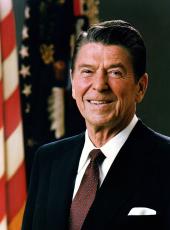
Statement by Principal Deputy Press Secretary Speakes on the Soviet Nuclear Reactor Accident at Chernobyl
The President yesterday, aboard Air Force One, ordered the establishment of an interagency task force within the United States Government that would coordinate the government's response to the nuclear reactor accident at Chernobyl. The task force is under the direction of Lee Thomas, who is the Administrator of the Environmental Protection Agency [EPA], with representatives from EPA, the Department of Energy, the Department of the Air Force, National Oceanic and Atmospheric Administration, the Federal Aviation Administration, the Food and Drug Administration, the Nuclear Regulatory Commission, the Department of State, and the Central Intelligence Agency.
The group met yesterday, last evening, in Washington and will be meeting on a regular basis for the foreseeable future. The group is charged with providing continuous monitoring of any health and environmental implications resulting from the accident. EPA will provide daily press briefings based on information gathered by this task force in order to keep the public informed.
Based on the latest data that has been gathered since we learned of the accident, it appears that the radioactive air mass from the Chernobyl nuclear reactor accident in the Soviet Union is currently moving over the Soviet Union. During the next few days, it is expected that the air mass will be dispersed by normal atmospheric activity. It is too early to determine whether any portion of the radioactive air mass will reach the continental United States. However, from the latest information we now have, should any radiation reach the United States, it is highly unlikely that it would be a level that would pose any threat to public health. This is because of the dispersion which would take place in the atmosphere. The Environmental Protection Agency, which maintains the Nation's radiation monitoring network, has increased its sampling frequency to a daily basis for airborne radioactivity.
Information available to us indicates that the Soviet reactor accident occurred in the fourth and newest reactor at the Chernobyl Power Station. This reactor is a graphite-moderated, pressure-tube reactor of a type called RBMK by the Soviets. The reactor suffered a major accident which included a fire at the graphite core. Given the amount and extent of the radiation released, the fire has destroyed most of the reactor's core. The reactor core contains approximately 200 tons of uranium interspersed with 1,700 tons of graphite. If the fire is not extinguished, it would probably continue to burn for days or weeks. The fire will continue to spread radiation from the core as long as it burns, although the Soviets have indicated that the rate of release is decreasing. Fighting the fire will be very difficult due to the extremely high levels of radiation near the reactor. The Soviets have asked some Western European countries for assistance in fighting the graphite fire, although no one in the world has experience in dealing with a situation like this. The British had a graphite fire in their reactor in the 1950's, but the radioactive contamination was much less.
On the diplomatic front, this morning Assistant Secretary of State for European and Canadian Affairs [Rozanne L. Ridgway] met the Soviet Charge Sokolov—that took place yesterday, eastern time. She expressed, on behalf of the President, the United States deep regret over the accident. We hope that the casualties and material damage will be minimal. The United States is prepared to make available to the Soviet Union humanitarian and technical assistance dealing with this accident. We are seeking additional information on the accident and request the closest possible coordinated effort among all concerned countries. To minimize the danger, we hope the Soviet Union will fulfill its international obligations to provide information on the accident in a timely manner. In order to state publicly the United States position and understanding of the situation, a briefing will be held in Washington on Wednesday at 11 a.m. at the State Department. Those briefers will include the Environmental Protection Agency, State Department, and Energy Department, as well as the Nuclear Regulatory Commission.
The State Department has told us that we do not have a count of all Americans in the Kiev area, since tourists are not under an obligation to inform the Department or the U.S. Embassy of their whereabouts. Embassy officers in the U.S.S.R. are in contact with Intourist and other Soviet authorities, but in order to trace an individual they need the Intourist group number or name or location and phone number, if possible, of the hotel in which the American citizen is thought to be staying.
Embassy Moscow has no reports of Americans affected by the accident. There have been no requests for medical assistance, evacuation, or other assistance by Americans. We have been informed that there are several American students who are traveling in the Soviet Union and are now in Kiev. The Soviet Government, of course, is responsible for ensuring that they are safely evacuated should it be required. Unfortunately, the Soviet Union has not told us what precautions that they are offering to protect our citizens that may be in the Soviet Union.
Note: Larry M. Speakes read the statement to reporters at 9:55 a.m. in the Bali Room at the Bali Sol Hotel, in Bali, Indonesia.
Ronald Reagan, Statement by Principal Deputy Press Secretary Speakes on the Soviet Nuclear Reactor Accident at Chernobyl Online by Gerhard Peters and John T. Woolley, The American Presidency Project https://www.presidency.ucsb.edu/node/258598
